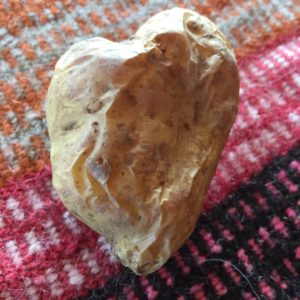
So what does a whole-foods, plant-based, low-fat diet include?
Whole or near whole food. That means foods in their original states or as close to it as possible. The more whole, the less processed, the better.
Plant-based food. Fruit, vegetables, beans, legumes, whole grains, nuts, and seeds.
Low fat/no oil food. Removing animal foods from the diet alone knocks fat intake way down. As does skipping oil in recipes and food preparation. Some plant foods, though, are also high in fat – nuts, avocados, coconut – so their inclusion is best in small amounts or as a flavoring, and in keeping with individual goals and metabolism. Hubs Erin can eat nuts without weight gain. For me, higher-fat plant foods are more rare indulgences.
Note: Plants, even greens, contain fat, so going low-fat and plant-based never means no fat.
For us, starch-centric food. While all those I follow – T. Colin and Tom Campbell, MD, John McDougall, MD, Caldwell Esselstyn, MD, and Neal Barnard, MD among others – encourage essentially the same diet, some encourage more elements over others. McDougall emphasizes the age-old need for starch – being potatoes, rice, corn, or pasta – to be the central constant for satiety. Esselstyn, who works with people to prevent and reverse heart disease, emphasizes the need for frequent and plentiful greens. All agree oil. Oil is highly processed and is exceptionally calorie dense and devoid of nutrients.
McDougall’s The Starch Solution approach has been a godsend for me. Eating plenty of starch means fullness and satisfaction. Eating in this manner has eliminated the crazed hunger spikes I’d have before, in which I had to have something, anything. I get hungry now, but if I can’t eat right away the delay is manageable. Given my mom’s early death to cardiac arrest and my dad’s heart issues – I eat lots and lots of greens. Kale, yeah!
We eat A LOT of potatoes, yams, and brown rice. We eat whole grain pasta, corn and wheat tortillas, and whole grain bread on occasion.
What about salt and sugar?
Simply eating a whole-foods, plant-based, low-fat diet eliminates vast quantities of salt and sugar which lurk in processed foods. Check! I buy unsweetened and unsalted foods for the most part, and if needed, add some a little salt or sugar when cooking or at the table for a net result of vastly reduced salt and sugar intake. For sweetening we use maple syrup, agave, molasses, and on occasion rare occasion turbinado sugar. I don’t use, and avoid, high-fructose syrup at all costs, which requires vigilance as it’s a common ingredient in condiments, most soups, crackers, and breads. Not only is it hyper sweet and addicting (well documented), in my experience it messes with my natural fullness and satiety sensors. Drs. Campbell and McDougall note that if a little table salt or sugar help a person transition to a plant-based diet, that’s okay, and that one’s taste for hyper salty and sweet goods will fade away. That’s been my experience.
Is eating a whole-foods, plant-based, diet boring?
No, not after a bit. If your diet – like ours – was high in fat, butter and oil, salt, and sugar, then plant-based food prepared with table salt or sweetening can seem plain at first. I’ve read that taste buds will make the shift in a week or two. (Juicing for a week prior to shifting to plant-based food helped us, but that’s an expensive and not so filling route to go.)
I’ve been eating this way for five-plus years now and my taste buds’ ability to sense variety and flavor is still on the rise. I actually feel like I have more ingredients to play with and more flavor on my tongue. And I actually crave particular beans and legumes in particular. Before? A bean was a bean.
Condiments? Salsa, Tabasco, and Sriracha are our most frequently used condiments, followed by tamari, low-sodium soy sauce, mustard, chili sauce, and Bragg’s Liquid Aminos. (Update: Anymore tamari, soy, and Bragg’s taste too salty.) Some people like Bragg’s Nutritional Yeast as a topper; I enjoy it more as an ingredient. We also use a lot of vinegars: balsamic, wine, rice, apple cider. I’ve struggled to find a barbecue sauce free of sugar or high fructose corn syrup, so I’m going to make one of my own. Everything I mentioned is commonplace on a WFPB diet. (Update: Last year we made 20 batches of ketchup with our excess tomato harvest, using very little sugar. That was really good!)
And to drink?
Thumbs up to water, plant-based milks, caffeine-free teas, hot water straight up with a slice of lemon, orange, or a sprig of mint. Mineral water, club soda, unsweetened selzer. Very, very occasionally juice (it’s highly processed and stripped of many beneficials and jacked up in sugar content, but in small quantities not harmful).
Thumbs of caution to coffee, beer, wine, and alcohol, which are discouraged, especially in excess. The way I’m reading their advice – check it out for yourself – is that if you’re drinking coffee or alcohol and all other aspects of health are fine, okay. If not, cut back or cut it out.
What’s not on a whole-foods, plant-based, low-fat diet?
Beef, poultry, seafood, animal-based dairy, oil, highly processed foods and beverages (which include sodas and diet soda).
In Getting Started I write about our beginnings with whole-food, plant-based diet, which might be helpful to you.


